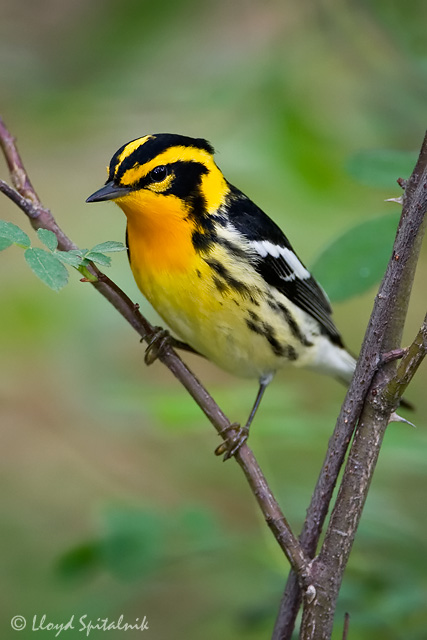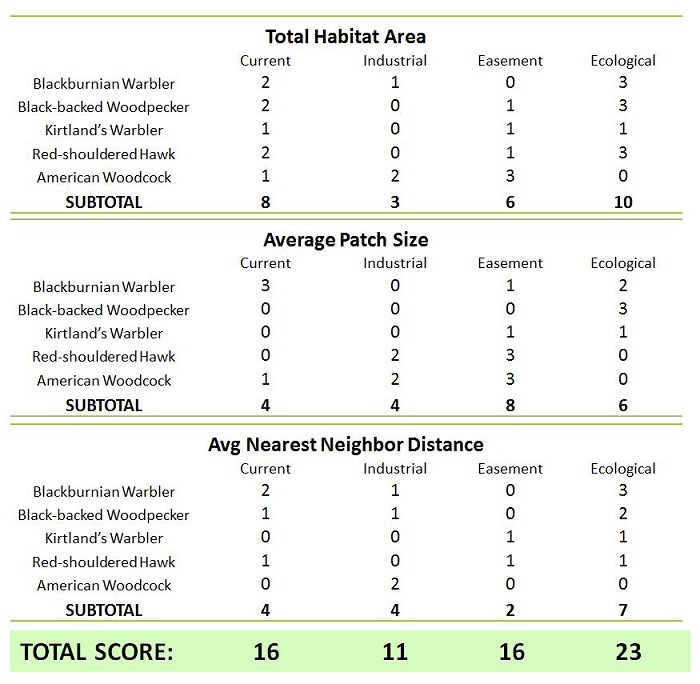Wildlife Responses

Habitat assessment for multiple bird species to evaluate conservation efficacy
Loss and fragmentation of habitat are two of the greatest threats to forest wildlife biodiversity. In conservation planning, decisions must be made about where and how much habitat to protect for which species. Due to differences in species habitat requirements, this can be difficult. Examining our scenario map outputs for how they may provide habitat for wildlife offers insight into how and where species habitat might change over time, which provides a means of comparing the potential effectiveness of different conservation strategies, understanding tradeoffs of managing for one objective versus another, and preparing for adaptive management.
A suite of species which are sensitive to human disturbance can be prioritized and selected to represent the diversity of habitat composition and configuration characteristics that are of conservation concern in a landscape. Bird species generally have specialized habitat preferences which are well documented and understood. Five bird species of local conservation concern were chosen as target species for the Two Hearted River watershed—the Blackburnian Warbler (Dendroica fusca), Black-backed Woodpecker (Picoides arcticus), Kirtland's Warbler (Dendroica kirtlandii), Red-shouldered Hawk (Buteo lineatus), and American Woodcock (Scolopax minor).
Using maps of projected future land cover under each landscape scenario, habitat was modeled in a GIS environment and evaluated for each species. In addition to measuring total habitat area, which is a direct measurement of habitat availability and is generally used in defining conservation goals, two metrics of spatial configuration were calculated—average patch size and average patch nearest neighbor distance. Larger patch sizes may reduce a population's probability of extinction by supporting larger population sizes, enabling greater colonization rates, and reducing edge effects and predator invasions. Greater patch connectivity may enhance dispersal success, colonization, and population interchange, especially for rare and specialist species in degraded or fragmented landscapes.
To determine the relative performance of each scenario, we ranked the scenarios using a scoring system as shown in the table below. Each scenario received one point for every other scenario it surpassed in performance based on having significantly more total habitat area, larger average patch size, and closer average nearest neighbor distance. In effect, higher scores were given to scenarios with habitat metric results that represented more favorable habitat conditions. We summed the points across all species and habitat metrics to determine a final overall performance ranking for each scenario.
Main Findings
The amount and configuration of habitat for all target species were significantly influenced by the different conservation strategies represented in the scenarios at 100 years into the future. For example, view the changes in habitat availability for each of the five target species under the Ecological Forestry scenario in the map below.
Explore this map in a new window.

Scenario Rankings
Scenario rankings were generally related to the amount of even-aged timber management (eg. clear-cutting)—the Ecological scenario with the least even-aged management ranked the highest (shown in the map above), while the Industrial Forestry scenario with the most even-aged management ranked the lowest (shown in the map below).
- The Ecological Forestry scenario had the most positive impacts on habitat over the modeled time period, indicating that cooperative management for ecological returns across ownerships would have the greatest benefits to wildlife.
- The Current Management and Expanded Easement scenarios performed similarly over the modeled time period, which suggests that the current amount of fee simple land would not offer more benefits than those lands being under conservation easements. However, if total habitat area was the only metric considered, the Current Management scenario performed better.
- No one scenario ranked the highest for all three landscape patch metrics across all five target species. For example, the Expanded Easement scenario ranked the lowest for average patch nearest neighbor distance, but ranked the highest for average patch size. The Ecological scenario did not rank the highest for average patch size. Here, patch refers to an area of suitable habitat for a target species surrounded by a forest or wetland cover.
- There were general declines in habitat area and connectivity over time, calling for a need to apply additional strategies that retain old-growth structure and aggregated habitat areas, such as longer harvest rotations, reducing harvest intensity, and establishing old-growth reserves.
- The American Woodcock habitat showed contrasted responses to the other species, indicating that management for this one species would have negative impacts on the broader array of species dependent on older forests and forest interior habitat.
Explore this map in a new window.
Climate change scenarios revealed exaggerated effects of disturbance on habitat. Habitat area totals were lower, average patch sizes were smaller, and average patch nearest neighbor distances were greater than in the corresponding non-climate change scenarios. However, the effect was opposite for the American Woodcock, which would benefit from the climate change conditions.
Considering climate change scenario rankings, the Ecological Forestry and Current Management scenarios tied as the highest scoring, suggesting that factors such as cooperative restoration-style forest management and fee simple purchased lands may provide the most effective protection against habitat loss due to possible climate change impacts of increased fire and windthrow events.
When considering optimization and efficiency for conservation planning, there is a need to define objectives such as total habitat area to support a minimum viable population size, in order to determine how well these conservation strategies would support species populations, and how much effort and resources would be necessary. The habitat assessment outputs here provide a means for pursuing further analyses such as population viability analysis, gap crossing models, and optimal allocation approaches.